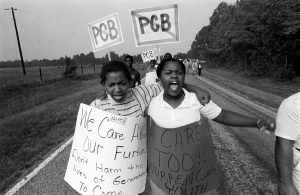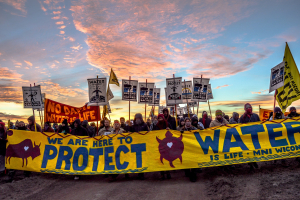Introduction to EJ History in the U.S.
By: Thora Middleton, Office of Sustainability Initiatives Intern, July 2020
The EJ movement rose up along with the Civil Rights Movement of the 1960s, when people started to see the public health dangers of environmental injustice. This movement was started primarily by people of color who wanted to address the deep inequity of environmental protection in their communities (EPA, 2017). The Memphis Sanitation Strike of 1968 was the first time African Americans had mobilized a national, broad-based group to advocate for better working conditions and pay (EPA, 2017).

African Americans mobilized a national, broad-based group again in Warren County, North Carolina in 1982. The 1976 Resource Conservation & Recovery Act (RCRA) required proper disposal of polychlorinated biphenyls (PCBs) due to their toxic carcinogenic nature. To comply, the State of North Carolina decided to build a new landfill in Warren County, NC, a very poor, predominately African America county with no political representation. People protested the landfill and over 500 environmentalists and civil rights activists were arrested during the marches and peaceful sit in. Although the protest was unsuccessful in halting construction, this event is widely accepted as the catalyst for the modern day EJ movement. (EPA, 2017)
The United States General Accounting Office (GAO) conducted a study after the Warren County protest and found that three out of four hazardous waste landfills in the US were located in communities where the residents were predominately African American and/or living below the poverty line (EPA, 2017). Community organizers from across the country have been forming coalitions, putting their personal safety on the line, and using their voices in all ways possible to raise public consciousness about environmental injustices ever since. Because of their work and sacrifice, we now are more aware of the correlation between the location of various polluting industries to low-income communities and communities of color. Their collective voices have been raised to influence local and national policies, most recently shaping the H.R. 5986, the Environmental Justice for All Act, currently under consideration.

The Standing Rock Protest in opposition of the construction of the Dakota Access Pipeline of 2016 shined a light on the contemporary EJ movement among Indigenous people, but it also highlighted how little average Americans know about the struggles of Native peoples to be recognized in the environmental movement. For centuries, Native people have had their land and rights stripped away, including their right to clean, safe and environmentally healthy communities. In 2002 it was highlighted that 317 out of the 500 total reservations were threatened by environmental hazards – including radioactive waste, mining, clear cuts, and pollution (Clark, 2002). In 2014, the EPA completed its Policy on Environmental Justice for Working with Federally-Recognized Tribes and Indigenous Peoples, which is “designed to better clarify and integrate environmental justice principles in a consistent manner in the Agency’s work with federally recognized tribes and indigenous peoples.” (EPA, 2014)
This week, after years of organizing, protesting, lobbying, and educating, coalitions anchored by indigenous communities saw courts uphold their calls to end construction of the Atlantic Coast pipeline, as well as to halt progress on the Dakota Access pipeline project and to deny a permit to the Keystone XL pipeline. Take the time this week to learn more about the many landmark moments created by people involved in building the EJ movement and to consider ways you can support today’s advocates and EJ leaders through donations of your time, funds and skills; by calling your representatives to ask for more political support for EJ efforts; and by sharing stories and visions for our communities from the movement.
Sources Cited
Clark, B. (2002). The Indigenous Environmental Movement in the United States. Organization & Environment, 15(4), 410-442. doi:10.1177/1086026602238170
Environmental Protection Agency (EPA). (2014, July 24). EPA Policy on Environmental Justice for Working with Federally Recognized Tribes and Indigenous Peoples [PDF file]. https://www.epa.gov/sites/production/files/2017-10/documents/ej-indigenous-policy.pdf
Environmental Protection Agency (EPA). (2017, June 02). Environmental Justice Timeline. https://www.epa.gov/environmentaljustice/environmental-justice-timeline

I think environmental and national policies should somewhat work together https://www.0mfq.com/search/ecology-sociology/ and through the communications of lobbying and history new eras can begin to accomodate